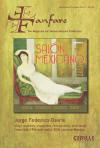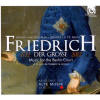Texte paru dans: / Appeared in:

Fanfare Magazine: 36:1 (09-10/2012)
Pour
s'abonner / Subscription information
Les abonnés à Fanfare Magazine ont accès aux archives du
magazine sur internet.
Subscribers to Fanfare Magazine have access to the archives of the magazine
on the net.
Harmonia Mundi
HMC902132

3149020213223
Consultez toutes les évaluations recensées pour ce cd
~~~~ Reach all the evaluations located for this CD
Johann Gottlieb Graun (1703–71) is represented here by two works. Sometimes overshadowed by the achievements of his brother Carl Heinrich (1704–59), one of the most important German mid-century composers of Italian opera, Johann Gottlieb worked at Frederick’s court as a violinist and composer. His Overture and Allegro in D Minor are fine examples of a composer who deserves more recognition than he is currently receiving. The overture in the French style receives a stylish and rivetingly precise treatment at the hands of Stephan Mai (directing from the violin) and the orchestra. This is a group that is not afraid to explore contrast in dynamic, articulation, and color, including experimenting with scoring; the repeat of the allegro in the overture opens with winds and no strings, highlighting the rich and reedy sound of oboists Xenia Löffler and Michael Bosch and bassoonist Christian Beuse.
Graun’s A-Minor Gamba Concerto is a real monster. One of five concerti that Graun wrote for Frederick’s court gambist, the virtuoso Ludwig Christian Hesse, the piece clocks in at nearly 25 minutes. The first movement is tempestuous, with sudden silences and dramatic ebbs and flows, demanding virtuosity and precision from not only the soloist but the orchestra as well. A tender Arioso in C Major provides a respite from the drama, but does not let up on the technical demands, while the closing Allegro blends fireworks with elegant restraint. Gambist Jan Freiheit handles the demanding solo part with grace and power. However, the recording’s engineering does not do him any favors, creating a thunderously booming bass while leaving the gamba’s highest register sounding waifish and whiny at times. It simply cannot compare to the depth, power, and sparkle of Vittorio Ghielmi’s 1998 recording of the same concerto with Limoges Baroque Ensemble (Astrée 8617).
Christoph Nichelmann (1717–62) studied with both Johann Sebastian and Wilhelm Friedemann Bach, and served as second harpsichordist at Frederick’s court from 1745 to 1756. The Concerto in C Minor on this album, one of at least 20 concerti for harpsichord and orchestra Nichelmann composed, shows the stylistic influence of both the elder Bach and the newer empfindsamer, or sensitive style, championed by C. P. E. Bach and the Grauns, and even points toward early Classicism. On this recording, keyboardist Raphael Alpermann plays the solo on fortepiano, but delivers a puzzling interpretation. While his articulation is searingly crisp and perfectly executed, he does not fully take advantage of the fortepiano’s expressive capabilities through techniques carried over from expressive harpsichord playing, such as rolling chords for greater emphasis or slightly dislocating a melody note as an accent. The result is disconcertingly reminiscent of Glenn Gould’s Bach recordings, and odd, considering Alpermann’s stylish, rhythmic, and expressive harpsichord playing on the Graun and Bach works and his fortepiano continuo on Frederick the Great’s Flute Sonata in C Minor, a pleasant work with its most interesting feature being its dramatic opening recitative.
The album
closes with C. P. E. Bach’s quirky and fun Symphony in D, once again
demonstrating the orchestra’s ability to turn on a dime, bringing out the
striking tempo and affect changes that define the younger Bach’s style. The
second movement is a tender accompanied duet between flute and viola da
gamba, elegant and refined, and beautifully played by gambist Freiheit and
flutist Christoph Huntgeburth. As on the rest of the album, the soundstage
is close, yet wide enough to capture the space between instruments. Except
for the unfortunate EQ problems with the gamba concerto, it makes for a
delightful if idealized listening experience, with every instrumental color
coming through clearly and independently without sacrificing blend and a
sense of space, important conditions necessary for this capricious, witty,
and highly expressive music to come alive.
Fermer la fenêtre/Close window
Cliquez l'un ou l'autre
bouton pour découvrir bien d'autres critiques de CD
Click either button for many other reviews


